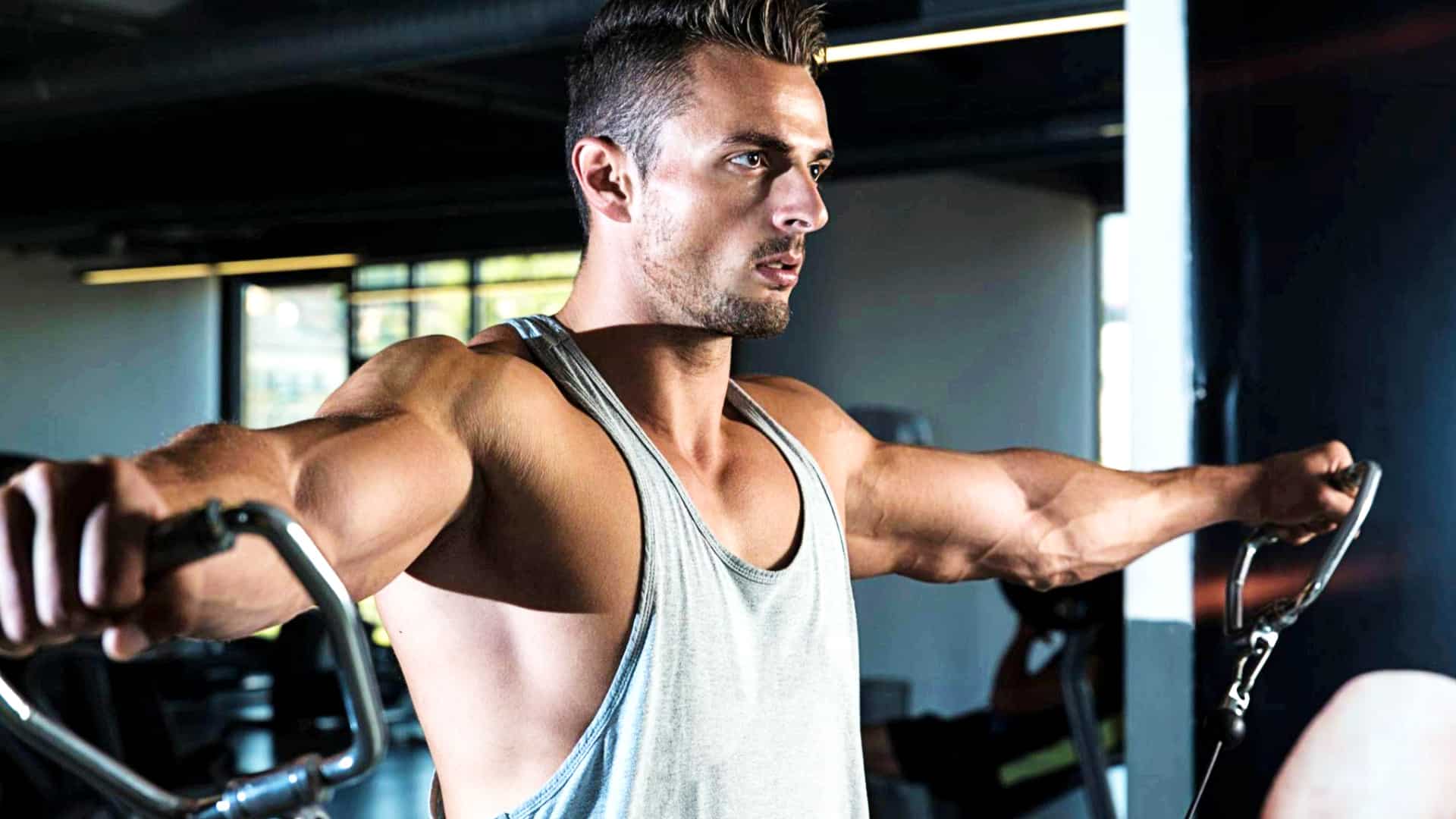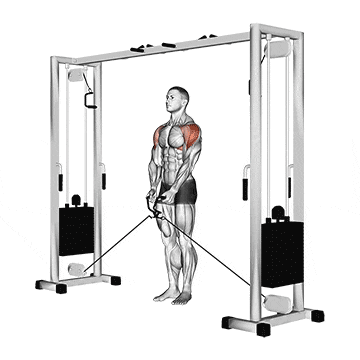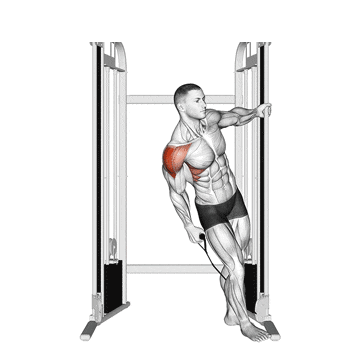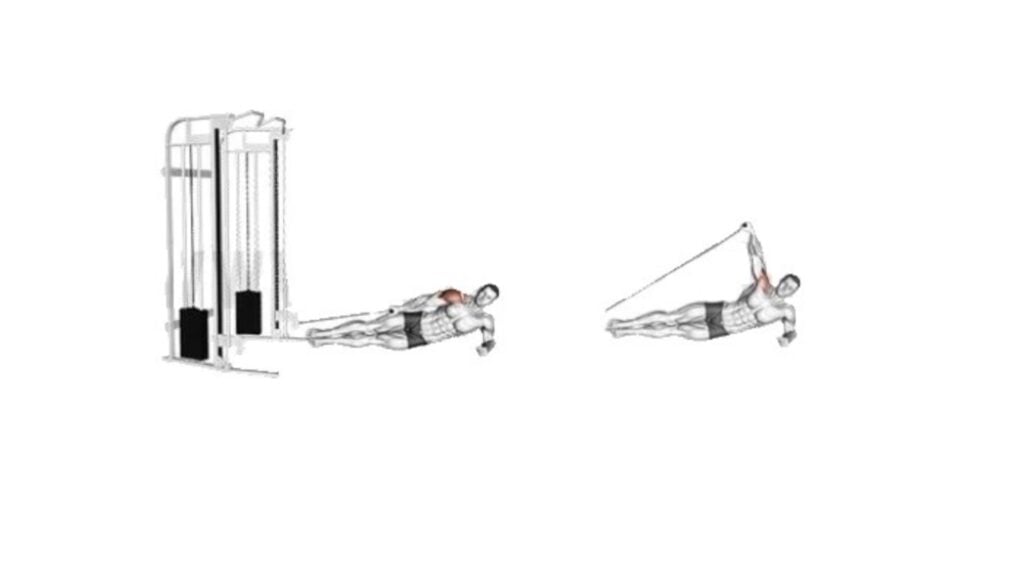The Cable Lateral Raise is an isolation exercise that primarily works the shoulder muscles, particularly the lateral or side deltoid muscles.
Unlike dumbbells, where the tension may vary, a cable lateral raise provides a more stable and consistent resistance that helps you to isolate and engage the side delt effectively.
There are several variations of the cable-side raise, but they all share the same primary goal: building and strengthening the lateral deltoids.
Research indicates that combining lateral and frontal raises can lead to greater shoulder strength gains than just one exercise. This is because lateral raises primarily target the middle deltoid, while frontal raises emphasize the anterior deltoid.
It would be best if you tried a cable lateral and front raise variation to build stronger muscles and make your shoulders full and round.

Muscle Worked During Cable Lateral Raises
- Primary Muscle Worked: Lateral deltoid.
- Secondary and stabilization Muscle Worked: Anterior deltoid, posterior deltoid, trapezius, supraspinatus.
Leaning cable lateral raise primarily trains the middle delt; however, the activation for secondary muscles changed due to changes in the humeral external and internal rotation.
How To Do Single Arm Cable Lateral Raise
- Set the pulley to the lowest position. Attach a single handle to the cable.
- Stand sideways to the machine with your feet shoulder-width apart. Grab the handle with your outside hand (the one farthest from the machine).
- To maintain good posture, push your chest forward, and point your shoulders back while slightly bending both knees.
- Slowly lift your arm to the side until it’s parallel to the floor. Keep a slight bend in your elbow and lead with your elbow, not your hand.
- Hold for a second, and then slowly lower the weight back to the starting position.
- Do 3 sets of 12-15 reps on each arm.
Cable Lateral Raises Form and Tips
- Maintain a slight bend in your elbow (about 10-15 degrees). This reduces stress on the elbow joint and keeps tension on the deltoid muscle.
- Ensure your wrist, elbow, and shoulder stay in a straight line throughout the movement.
- Only lift your arm to shoulder height. Going higher can shift tension away from the lateral deltoid and engage other muscles like the upper traps.
- Use a controlled tempo—2 seconds to lift, hold for 1 second at the top, and 2 seconds to lower.
- You should always use weights that you are able to lift comfortably.
- Keep your shoulder blades retracted and depressed (down and back).
Best Variations of Lateral Cable Raises
There are many excellent variations of the cable lateral raise that you can try to build bigger deltoids.
- The lateral raise of both arm cables simultaneously activates both deltoids and ensures even development.
- The lean-away lateral raise is an outstanding exercise, especially popular with bodybuilders and athletes.
- Another popular variation is the behind-the-body lateral raise. It is excellent for targeting the side deltoid and even the side-rear deltoid.
- The fourth variation is the Side Lying Cable Lateral Raise; it’s the creative way to train the lateral deltoid with cable
1. Both Arm Cable Lateral Raise
As you gain strength, add a dual cable setup (one on each side) to provide balanced resistance throughout the range of motion.
The dual arm cable lateral raise encourages balanced activation of the lateral deltoids. Both sides work simultaneously, which helps in developing symmetrical shoulders.

- Attach two handles to the low pulleys of a cable machine.
- Grab the handles with a neutral grip (palms facing each other) and let your arms hang naturally by your sides.
- Simultaneously, raise both arms out to the sides.
- Slowly lower your arms back to the starting position.
2. Leaning Cable Lateral Raise
Compared with the standing cable lateral raise, the leaning cable side lateral raise puts your lateral deltoid under tension through a more significant portion of the range of motion, making each repetition more effective.
Leaning cable lateral raise strengthens the stabilizing muscles in your shoulders and improves your muscle balance. It also places greater overload at the top of the raise.
It is also one of the most effective exercises for strengthening and growing the shoulder muscles.

How to Do
- Stand next to a cable pulley machine with the handle attachment adjusted to the lowest.
- With the outside arm, grab the handle with your arm fully extended.
- Grip the machine with your inside arm for support.
- Now, place your feet close to the pulley machine, allowing you to lean away from the machine.
- Raise your arm to shoulder height, then lower the weight back to the starting position.
3. Side Lying Cable Lateral Raise
The unique body position reduces the chance of cheating and enhances proprioception and improves the mind-muscle connection with the lateral deltoid.
The side-lying position makes it safer for people with lower back problems. You can do it performed on the floor or on a bench.

How To Do
- Set the stirrup at the lowest point. Lie down on your side with your feet towards the cable machine, then grab the stirrup with an overhand grip using your upper arm.
- Brace your upper body with your elbow on the ground directly under your shoulder,
- Lift until your arm parallels your shoulder.
- Slowly return to the starting position.
Cable Lateral Raise Alternatives
If the cable machine is not accessible, you may also be searching for an alternative to the cable lateral riase. Below are some suggestions.
- Dumbbell Lateral Raise
- Barbell Overhead Press
- Machine Lateral Raise
- Dumbbell One Arm Lateral Raise
- Upright Row

Manish is a NASM-certified fitness and nutrition coach with over 10 years of experience in weight lifting and fat loss fitness coaching. He specializes in gym-based training and has a lot of knowledge about exercise, lifting technique, biomechanics, and more.
Through “Fit Life Regime,” he generously shares the insights he’s gained over a decade in the field. His goal is to equip others with the knowledge to start their own fitness journey.
